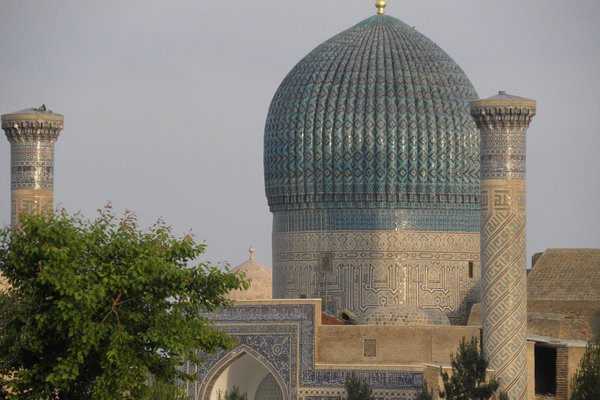Uzbekistan
Samarkand
Samarkand - Crossroad of Cultures is a city with ancient origins that saw its heyday during the Temurid period.
From its early days, the archeological site of the city of Afrosiab remains. The Temurid medieval city has preserved its urban fabric, monumental buildings and traditional housing. Its Timurid architecture decorated with ceramic tiles became a worldwide influence in Islamic art and architecture. The 19th and 20th-century Russian expansions of the city show its urban continuity.
Community Perspective: The individual monuments stand out here more than the overall atmosphere, with the highlights being the Registan ensemble, the Bibi-Khanym Mosque, the Shahr-i-Zindah tombs, the Guri Amir Mausoleum and the Ulughbek Observatory. Behind the scenes, it’s not all that shiny, as the interiors often disappoint and much of the restoration work is shoddy.
Site Info
Official Information
- Full Name
- Samarkand - Crossroad of Cultures (ID: 603)
- Country
- Uzbekistan
- Status
-
Inscribed 2001
Site history
History of Samarkand
- 2012: Name change
- From "Samarkand - Crossroads of Cultures" to "Samarkand - Crossroad of Cultures"
- 2008: Reinforced Monitoring
- Threatened by new roads and buildings
- 2001: Revision
- Includes FTWHS Ishrathona (1996-2005)
- 2001: Inscribed
- Inscribed
- 1996: Revision
- Component parts such as Afrasiab and Ulughbek Observatory appeared on T List (1996)
- 1991: Referred
- Bureau - Awaiting USSR to propose a new site based only on Muslim monuments
- Type
- Cultural
- Criteria
- i
- ii
- iv
Links
- UNESCO
- whc.unesco.org
- Official
-
- uzbekistan.travel — uzbekistan.travel Samarkand
- Related
-
- advantour.com — Link
All Links
UNESCO.org
- whc.unesco.org — whc.unesco.org/
Official Website
- uzbekistan.travel — uzbekistan.travel Samarkand
Related Resources
- advantour.com — Link
News Article
- Oct. 5, 2024 timesca.com — Qatar To Help Restore Uzbekistan’s Bibi-Khanym Mosque
- May 1, 2014 rferl.org — Construction Work Damages Samarkand's Registan
Community Information
- Community Category
- Archaeological site: South (East) Asian
- Urban landscape: Asian
Travel Information
Samarkand Hotspot
Recent Connections
-
Mentioned in Paradise Lost
"In Samarchand... Temir’s throne." Milt…
-
Works by Thomas Pynchon
"Kit had fallen into conversation with …
-
Ella Maillart
As part of her book Turkestan Solo (19…
Connections of Samarkand
- Individual People
-
-
Alexander the Great
He conquered it in 329 BC. -
Ibn Battuta
-
Ella Maillart
As part of her book Turkestan Solo (1932). https://www.ellamaillart.ch/photos-1?lightbox=dataItem-kjlm6dvp1
-
Timur
-
Travels of Hyecho
While most of the nominated monuments did not exist during Hyecho's time, the Afrosiab archaeological area was highly developed. It is also mentioned in the nomination file that Arab rulers turned ancient temples into mosques. "Only in Samarkand is there one monastery and monk, who does not know how to revere the 'Three Jewels'. In these countries of the Hu people, both the beard and hair are cut. People like to wear white caps made of cotton." - From the Diary of Hyecho -
Ella Maillart
As part of her book Turkestan Solo (1932) -
Xuanzang
Xuanzang crossed the desert from Tashkent further west to Samarkand. In Samarkand, the party came across some abandoned Buddhist temples and Xuanzang impressed the local king with his preaching.
-
- Trivia
-
-
Built or Owned by Chinese
Bibi-Khanym Mausoleum, Samarkand built by Chinese wife of Timur, Bibi -
On Banknotes
Registan; 50 Sum; 1994 -
In Video Games
Age of Empires II: Tatars: the Ulugh Beg observatory in Samarkand -
Sound and Light Show
There is nearly every evening after sunset a light show at the Registan
-
- History
-
-
Mongol Invasions
Siege of Samarkand (1220): "The citizens of the city soon surrendered at the instigation of the Muslim clergy; most were however enslaved or conscripted in traditional Mongol fashion." (wiki)See en.wikipedia.org
-
Located in a Former Capital
Timurlane et al 1530 - 1630 -
Silk Roads
Classic Land Route; "the city and the surrounding area were inhabited by the Sogdians, a people of Iranian origins renowned for their skill at trading. As early as Han times (206 BC-220 AD), when the Chinese first committed to writing their impressions of Inner Asia, Sogdian merchants are recorded in the Chinese descriptions of the region. Sogdian colonies were established all along the trade routes and Sogdian letters have been discovered from 313-314 AD, providing evidence about a network of merchants from Samarkand, reaching various places as far as China, in order to trade precious metals, spices and cloth. Sogdian inscriptions on rocks in northern Pakistan testify to their activity on the routes south into India. Later on, in the 6th century AD, Sogdian merchants seem to have travelled west and developed new routes for trade with Byzantium." (Silk Roads Programme)See en.unesco.org
-
- Architecture
-
-
Square Kufic
Bibi Khanum MosqueSee www.kufic.info
-
Timurid Architecture
The Gur-i Amir, the Bibi Khanum mosque, and the Shah-i Zindeh mausoleum complex (commissioned by Timur himself), plus two important examples of Timurid architecture from the period after Timur: the madrasah and observatory of Ulugh Beg -
Muqarnas
Shah-i-Zinda -
Glazed tiles
-
- World Heritage Process
-
-
Ten years or more to inscribe
1991-2001 -
Derived from more than one TWHS
Includes former TWHS Afrasiab and Ulughbek Observatory
-
- Religion and Belief
-
-
Russian Orthodox churches outside Russia
In the European Quarter -
Notable mosques
Bibi-Khanym Mosque (1399-1404), Sunni -
Shia Islam
Shrine of Kusam ibn Abbas. Cousin of Mohammed. Situated within the Shah-i Zinde complex. The name Shah-i-Zinda (meaning "The living king") is connected with the legend that Kusam ibn Abbas, the cousin of the prophet Muhammed was buried there. .. He came to Samarkand with the Arab invasion in the 7th century to preach Islam. Popular legends speak that he was beheaded for his faith. But he took his head and went into the deep well (Garden of Paradise), where he's still living now." (Wiki). Practice of Shia Islam is severely constrained within Uzbekistan but this site is listed in Wiki under "Holiest sites in Shia Islam". -
Tombs of Biblical Figures
another supposed location of the Tomb of Daniel. The "Khodja Daniyar" mausoleum (an alternative tradition is that it is the tomb of an early muslim preacher) See -
Jewish religion and culture
Gumbaz Synagogue and Jewish Mahalla
-
- Constructions
-
-
Necropolises
Shah-i-Zinda -
Cenotaph
Gur Emir Mausoleum: jade cenotaph of Tamerlane -
Mausolea
Shah-i-Zinda and the Guri Amir Mausoleum -
Bazaars and Market Halls
Siyob BazaarSee en.wikipedia.org
-
Dynastic Burial Places
(Gur-e Amir) family crypt of the Timurid Dynasty
-
- WHS on Other Lists
-
-
U.S. Ambassadors Fund
Preventive Conservation of the Collections of the Afrosiab Site Museum near Samarkand (2006), Preservation of 11th-Century and Later Korans in the Collection of the State Museum of Cultural History (2002)
-
- Timeline
-
-
Built in the 13th century
"The historic town of Samarkand illustrates in its art, architecture, and urban structure the most important stages of Central Asian cultural and political history from the 13th century to the present day". Registan Square was identified as the centre of the new city after the destruction of Afrosiab in 1220. Its heyday came with the Timurids in the 14th and 15th century.
-
- WHS Hotspots
-
-
Samarkand Hotspot
At the center of the hotspot
-
- Science and Technology
-
-
Astronomy and Astrology
Ulugh Beg's observatory
-
- WHS Names
-
-
Epic Subtitles
Crossroad of Cultures -
Name changes
From "Samarkand - Crossroads of Cultures" to "Samarkand - Crossroad of Cultures" (2012): grammatical change
-
- Literature & Film
-
-
Works by Thomas Pynchon
"Kit had fallen into conversation with a footplate man who was deadheading back out to Samarkland..." (Against the Day, pg. 752).
-
Mentioned in Paradise Lost
"In Samarchand... Temir’s throne." Milton identifies the city as the location of the "throne" or seat of Tamerlane, pinpointing the specific Silk Road capital. Tamerlane’s Capital
-
News
- timesca.com 10/05/2024
- Qatar To Help Restore Uzbekistan’s…
- rferl.org 05/01/2014
- Construction Work Damages Samarkan…
Recent Visitors
Visitors of Samarkand
- Adrian Turtschi
- Afshin Iranpour
- Alberto Rodriguez Gutierrez
- Alejandro Lau
- Alexander Barabanov
- Alexander Lehmann
- Alexander Parsons
- Alikander99
- Ali Zingstra
- Aljaz
- A. Mehmet Haksever
- Ammon Watkins
- AmyAbroad
- Ana
- Argo
- arnaugir
- Artur Anuszewski
- Ask Gudmundsen
- Aspasia
- Atila Ege
- bergecn
- Bill Maurmann
- Bin
- Bram de Bruin
- Carlos Sotelo
- chenboada
- Cheryl
- chiuliqi
- Christian Wagner
- christof
- Cirene Moraes
- Clyde
- Csaba Nováczky
- CugelVance
- CynthiaSam
- czesioszpachelka
- Danieljbromberg
- David Marton
- Deffra
- del
- Dimitar Krastev
- DjhMck
- DL
- Dorejd
- Dr. Caligari
- edstar500
- eljx1988
- Els Slots
- Emili Xaus
- Eric Lurio
- Erik Jelinek
- Eva Kisgyorgy
- Evgenii
- Fan Yibo
- fedemarch92
- Feldhase
- Fernweh
- Fmaiolo@yahoo.com
- Frederik Dawson
- George Gdanski
- Gernot
- Gilles
- giloudepuertorico
- giulio25
- Grzegorz Andruszkiewicz
- halryder
- Hammeel
- HaraldOest
- Harald T.
- Harry Mitsidis
- H Beswick
- henryjiao18
- hotpickle
- Iain Jackson
- Ingrid
- irosey
- Ivan Rucek
- Janos
- Jarek Pokrzywnicki
- Javier
- Jawnbeary
- Jean Lecaillon
- Jeffrey Chai
- JobStopar
- Jonas Kremer
- Jon Opol
- JoshHad
- Juha Sjoeblom
- jxrocky
- KarenBMoore
- Ken DJ
- Kevin McFarland
- Kevin Padley-Knight
- kiank37
- Krijn
- krtek
- La Concy
- Lado Joel
- Laetitia Yin
- Loic Pedras
- Lucio
- Ludvan
- Luis Filipe Gaspar
- Luke LOU
- Maciej Gil
- Maciej Gowin
- Maja
- Malgorzata Kopczynska
- marcel staron
- Marcobrey
- Martin
- Martina Rúčková
- MatusBeber
- Max
- Michael Ayers
- Michael Novins
- Michael Turtle
- Mihai Dascalu
- Mikko
- Milan Jirasek
- Miloš Tašković
- MMM
- Monica Tasciotti
- MoPython
- nan
- Niall Sclater
- Nihal Ege
- Patrik_globe
- Paul Schofield
- Philipp Leu
- Pieter Dijkshoorn
- Pink Bunny
- Piotr Wasil
- pressdm
- Rahelka
- ReallyDeepThoughts
- Reisedachs
- Reza
- Rick Ohm
- rivr
- Roger Ourset
- Roman Bruehwiler
- Sclowitz
- Sergio Arjona
- Simonf
- Solivagant
- Stan
- Stanislaw Warwas
- StaziG
- SymonMajewski
- Szucs Tamas
- Tamara Ratz
- Tarquinio_Superbo
- Tatiana Nikulnikova
- Thomas Buechler
- Timothy C Easton
- TimPick
- Tinamu
- Toxicologist
- Truls Brekke
- usagi1974
- Velvetlapis
- Vernon Prieto
- voyager
- Westwards
- Wo_ko
- Xiquinho Silva
- Yevhen Ivanovych
- Yongcheng Liu
- zfish
- Zizmondka
- Zoë Sheng
- Zos M
Community Reviews
Show full reviews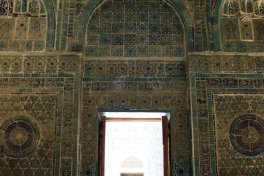
Samarkand is one of those cities which could easily be in the list a couple of times had they wanted to. And in a way it might have fit the place better, as Samarkand is better understood as a set of masterpieces that happen to be in a city. That is especially true compared to the likes of Bukhara or itchan Kala which shine because of their cohesion.
I would say there are 5 main components in Samarkand which could've had a decent shot to get into the list.
1. Gur e amir, this is the accidental mausoleum of the timurid dynasty (it wasn't built with that intent). Its rather small size is easily forgone once you see the luxurious decoration of the interior. I found it gave the best glimpse into the luxury Timur's palaces must've sported, which is otherwise hard to spot in Samarkand. Check out the jade wall tiles!
2. The Registan. The most iconic monument in Samarkand is indeed impressive. Here we get to see the famous timurid like for the monumental. Compared to later styles in the region the use of brick gives the madrasas an almost mellow colour and a much more elegant though less colorful appeal. It's perhaps the poster child of timurid architecture. I cannot talk about the interior because I was unfortunately not let in.
3. Bibi khanym mosque. This mosque was one of Timur's jewels for Samarkand. Built with the spoils of the sack of Delhi, …
Keep reading 0 comments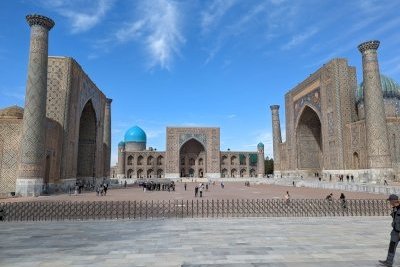
Looking at the places on my "to visit" list, Samarkand is the one that made the list first and stayed there the longest. My late aunt sometime in the 80s (or 90s?), had been to Uzbekistan and told me some mythical stories about her visit to Samarkand. I can't remember many details, but I think she was a bit challenged regarding customs and hygiene. In any case, I got Fernweh for the place: Wanting to go to Samarkand has stayed with me ever since.
I had planned to visit in 2020 but then Covid hit. Now, in 2022, I felt was the time to follow up.
Samarkand is a bustling city. It's not frozen in time, but modern Uzbekistan's second largest city. There are plenty of mosques, madrasahs and mausoleums spread across the city, with the Registan as the centre piece. But there is no old town to see.
The main tourist axis runs from the Registan via the Bibi-Khanum Mosque to the Schahi-Sinda complex. These are the highlights of any visit to Samarkand. There is a nice pedestrian zone connecting all sites and this is where most tourists congregate. Unlike Bukhara, Samarkand very much feels like an Uzbek city with locals being in the majority.
Other main components of the site are:
- Ulug Begs Observatory: You can take a cab or just walk from the Schahi-Sinda complex. Personally, I found that too little remains to appreciate the site much. When walking you …
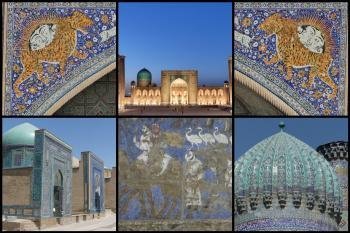
I visited this WHS in June 2017 over 4 days. It certainly is one of the best destinations in the world and certainly one of the top WHS on the list, not only for the exquisite beauty of all the single inscribed locations but also for the incredible ensemble this place must have been when constructed!
That said, I believe that Samarkand should be immediately put on the WHS in danger as the 'modern' and unprofessional patchwork of restorations/reconstructions risk ruining if not destroying the gems of Registan. That would certainly have a much stronger effect than delisting Shakhrisyabz as Uzbekistan's tourism is mainly based on Registan's allure. If I were to post the mortal sins I've photographed from Registan, I could easily have a negative impact on their tourism which is heavily dependent on European travellers. Instead I sent a letter to UNESCO and ICOMOS and I hope that they will take swift action to address such shoddy restoration works in the future. Still, the 3 madrasahs of Registan alone would be worthy of inscription and are hands down one of the best sites the WH list has to offer.
At night, if tour group/agencies pay around 1000 dollars (so I was told), a sound, light and laser show is put up - this equipment has led to some of the shoddy restorations! If you're not so lucky (or if like me you cherish visiting without too many tour groups, no show most probably means less people around), still …
Keep reading 0 comments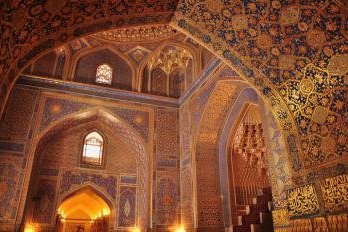
Samarkand is the reason why I decided to visit Uzbekistan, when I booked the ticket at Uzbekistan Airline office; I saw the poster of the very beautiful Registan so I asked the travel agent that should I trust the poster? The agent immediately said "You will see the better one at the real place!" After that Samarkand became the paradigm of my Uzbekistan itinerary. I arrived Samarkand in the evening, the traffic congestion greeted me with unexpectedly surprised, after a peaceful week in Khiva and Bukhara, Samarkand really reminded the chaotic life of modern urban!
I started my city tour at the Gur Amir Mausoleum, the resting place of Tamerlane; for exterior the beautiful blue mosaic dome was just amazing, and for interior the golden mosaics inside the building were just breathtaking, and in my opinion one of the most beautiful Muslim mausoleum I've ever seen. After the mausoleum, I went to Ulughbek Observatory, a ruin of very impressive ancient observatory, its museum was nice; however, many insightful information from my guide made me question the accuracy of the exhibition and object displayed. Then I continued my trip to see the famous Registan. With high hope and excitement, I found all magnificent three buildings complex to be exactly what I wanted to see, there facades were just magnificent with bright and colorful mosaics. However I was deeply disappointed with the bad status of the interior mosaics and glazed tiles inside the courtyard, seem that Uzbek used their whole money to …
Keep reading 0 comments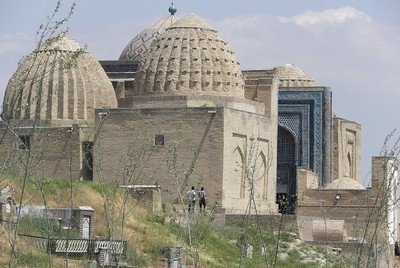
Samarkand is the site of the iconic Registan - the "sandy place" surrounded on three sides by Timurid madrasahs. You can sit on a bench on the fourth, open, side and take it all in - the turquoise tiles, the slender minarets, the imposing facades. The place attracts a lot of Uzbek tourists too. The madressahs can best be admired from the outside, as their interiors are completely taken over by the souvenir business. Only the middle (Tilya Kori) is worth a visit for its completely gilded interior including golden mosaics.
Somehow it had escaped my attention before that Samarkand has several other grand monuments than this Registan. Probably the best sight of my whole Uzbek/Turkmen tour was Shah-i-Zinda. This is a mausoleum complex, where the tombs are housed in the most ornamental little buildings. They feature all the mosaics and glazed tiles Samarkand is famous for, but on a more touchable scale than at the Registan. The place is also full of Uzbek pilgrims and daytrippers, creating a lively atmosphere (imagine visiting this wonderful site on your way from grocery shopping - I saw many Uzbeks carrying their round loaves of bread with them).
The tomb of Timur (Gur Emir Mausoleum) is the third site worth mentioning. On the inside, it has the feel of a European cathedral, with the tombs in the middle under a cupola and older Uzbeks praying around it.
Keep reading 0 comments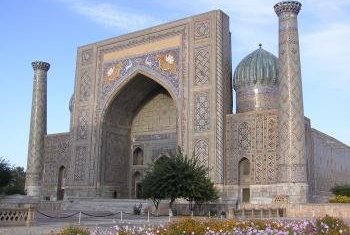
Samarkand is the largest of the WHS cities of Uzbekistan (c half million population). Possibly as a result it lacks much of the “eastern atmosphere” which can be sensed in Bukhara or Khiva – instead its glories consist primarily of 4 architectural wonders, any one of which on its own would justify a WHS inscription
a. The Registan ensemble
b. The Bibi-Khanym Mosque
c. The Shahr-i-Zindah tombs
d. The Guri Amir Mausoleum
Even if you are not a great lover of Islamic architecture these are all well worth seeing/experiencing. Back in Oct 2004 when this visit was made, if you went with a guide you needed to overcome the “shared out ticket price” scam! In theory you were allowed to return to any of these buildings several times during the day – but you needed to show the actual ticket! However the ladies on the gate didn't issue one (many tourists will not ask or care) and shared the money with the guide!! We weren’t able to persuade them to do so as that would have meant them all giving up their money..... but we did make sure that they would let us in again later that day!
There are other buildings worth seeing too – I particularly liked the Ulughbek Observatory with its 30mtr astrolabe partially set deep into the ground – an impressive example of the intellectual and scientific credentials of this part of the world before the European Renaissance. This is …
Keep reading 0 comments
